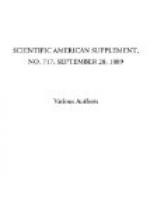My dear and most distinguished friend, the late Professor Polli, of Milan, tried to overcome the difficulties arising from the use of the coil by making ozone chemically, namely, by the decomposition of permanganate of potassa with strong sulphuric acid. He placed the permanganate in glass vessels, moistened it gradually with the acid, and then allowed the ozone, which is formed, to diffuse into the air. In this way he endeavored, as I had done, to purify the air of rooms, especially those vitiated by the breaths of many people. When he visited me, not very long before his death, he was enthusiastic as to the success that must attend the utilization of ozone for purification, and when I expressed a practical doubt, he rallied me by saying I must not desert my own child. At the theater La Scala, on the occasion of an unusually full attendance, Polli collected the condensible part of the exhaled organic matter, by means of a large glass bell filled with ice and placed over the circular opening in the roof, which corresponds with the large central light. The deposit on this bell was liquid and had a mouldy smell; was for some few days limpid, but then became very thick and had a nauseous odor. When mixed with a solution of one part glucose to four parts of water, and kept at a temperature of from 20 deg. to 24 deg. C., this liquid underwent a slow fermentation, with the formation, on the superficies, of green must; during the same period of time, and placed under the same conditions, a similar glucose solution underwent no change whatever.
By the use of his ozone bottles Polli believed that he had supplied a means most suitable for directly destroying in the air miasmatic principles, without otherwise interfering with the respiratory functions. The ozonized air had neither a powerful nor an offensive smell, and it might be easily and economically made. The smell of ozone was scarcely perceptible, and was far less disagreeable than chlorine, bromine, and iodine, while it was more efficacious than either of these; if, therefore, its application as a purifier of a vitiated air succeeded, it would probably supply all the exigences of defective ventilation in crowded atmospheres. In confined places vessels might be placed containing mixtures of permanganate of potassa or soda and acid in proper quantities, and of which the duration of the action was known; or sulphuric acid could be dropped upon the permanganate.
This idea of applying ozone was no doubt very ingenious, and in the bottles before us on the table, which have been prepared in Hastings by Mr. Rossiter, we see it in operation. The disadvantages of the plan are that manipulation with strong sulphuric acid is never an agreeable or safe process, and that the ozone evolved cannot be on a large scale without considerable trouble.
In 1875 Dr. Lender published a process for the production of ozone. In this process he used equal parts of manganese, permanganate of potash, and oxalic acid. When this mixture is placed in contact with water, ozone is quickly generated. For a room of medium size two spoonfuls of this powder, placed in a dish and occasionally diluted with water, would be sufficient. As the ozone is developed, it disinfects the surrounding air without producing cough.




